
Cherrapunji, Meghalaya – Nestled in the East Khasi Hills district of Meghalaya, Cherrapunji, also known as Sohra, is globally renowned as one of the wettest places on Earth. Located in the Lower Cherrapunji region, within the Sohra Civil Sub-division, lies the village of Mawmluh, home to around 1,500 residents. Perched on the edge of the Sohra plateau before the hills descend, this small village is redefining sustainable tourism by turning its unique geological heritage into a thriving local opportunity.
Unlocking the Village’s Tourism Potential
Surrounded by rolling hills, lush forests, and cascading waterfalls, Mawmluh offers breathtaking natural beauty. But beyond the scenic landscape lies a deeper story — a legacy carved in stone. Mawmluh is home to one of the longest and deepest cave systems in India, the Mawmluh Cave, located at an elevation of 1,200 metres. More than just a tourist attraction, the cave is a significant geological landmark holding vital evidence of Earth’s ancient climate history.
The cave plays a central role in defining the geological time scale, which categorizes Earth’s history based on key geological and biological events. The smallest unit of this scale is the geological age, and the present age, known as the Meghalayan Age, owes its name and identity to Mawmluh.
The Birthplace of the Meghalayan Age
Around 4,200 years ago, Earth experienced a major climatic shift during the Holocene epoch. The most conclusive evidence of this transformation was discovered within the stalagmites of Mawmluh Cave. Scientists identified a shift in the ratio of oxygen isotopes preserved in these cave formations, which pointed to a significant global climate event.
Recognizing the importance of these findings, the International Commission on Stratigraphy (ICS) officially designated the past 4,200 years as the Meghalayan Age in 2018. Mawmluh Cave became the first site in India to be named a Global Boundary Stratotype Section and Point (GSSP) — an internationally recognized reference point marking a change in geological time.
Further affirming its importance, the International Union of Geological Sciences (IUGS), in collaboration with UNESCO, declared Mawmluh Cave a geological heritage site in 2022.
A Model for Community-Led Sustainable Tourism
With its geological significance now recognized on a global scale, Mawmluh village has developed a community-driven tourism model that is both sustainable and inclusive. The initiative harnesses the village’s natural biodiversity, forest ecosystems, and the unique cave networks, drawing eco-conscious travelers and researchers alike.
Local residents are directly benefiting from this tourism model through employment opportunities, homestay services, guided tours, and conservation work, helping to preserve both the environment and cultural heritage.
By leveraging its distinct geological identity, Mawmluh stands as a shining example of how science, heritage, and sustainable tourism can come together to uplift communities and celebrate Earth’s deep-time history.
